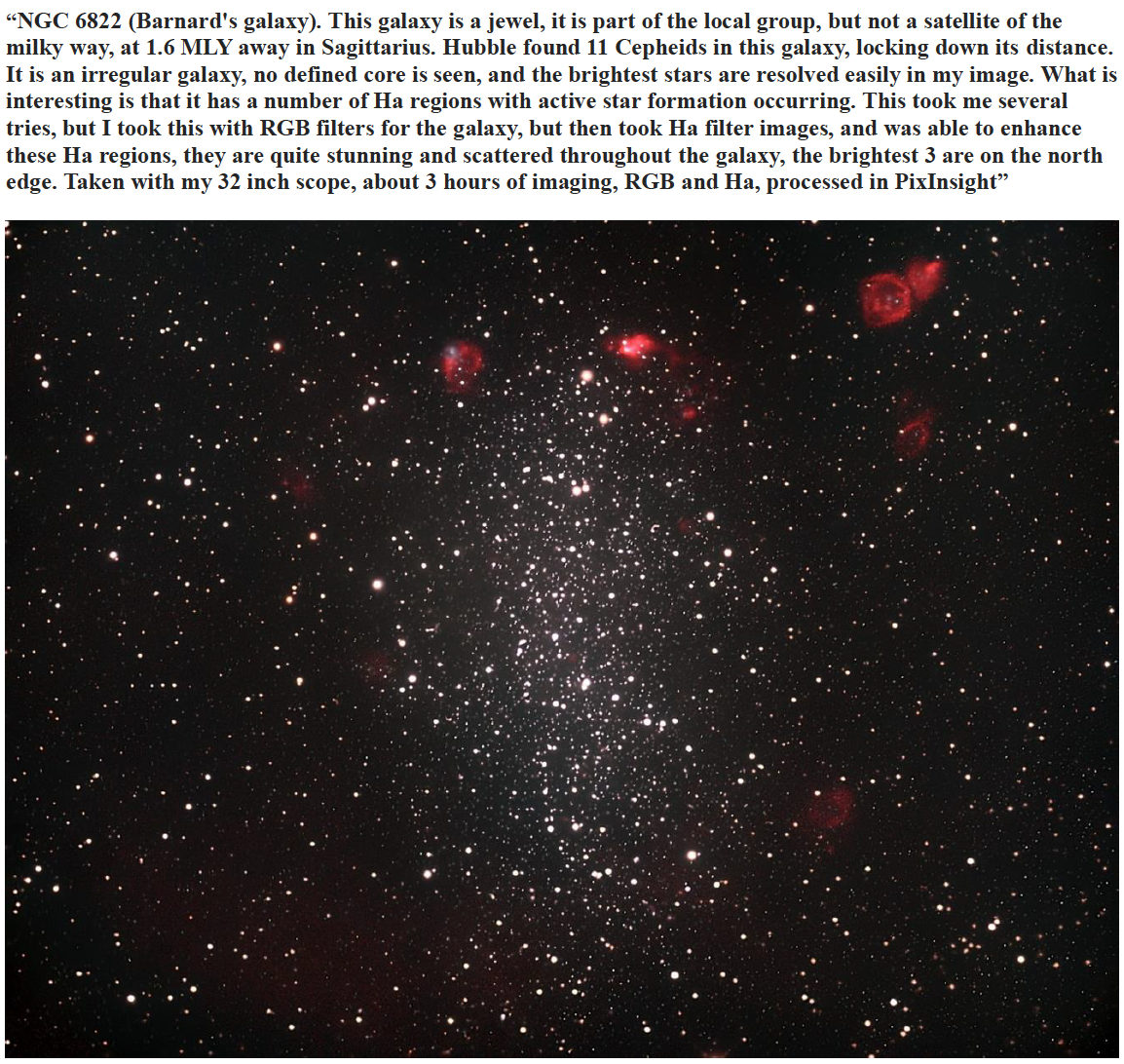Observer’s Challenge – September, 2024 by Glenn Chaple
NGC 6822 – Barred Barred Irregular Galaxy in Sagittarius (Mag 9.3; Size 15.5” X 13.5’)
Last month’s Observer’s Challenge, the galaxy NGC 6703 in Lyra, escaped the eyes of both William Herschel and his son, John, primarily because of its relative faintness (magnitude 11.3) and small size (just 2.4 arc-minutes). Would a brighter and larger galaxy be easier to view? Ask anyone who has tried to catch a glimpse of this month’s Challenge, NGC 6822 (“Barnard’s Galaxy” in Sagittarius), and you’ll get a resounding “No!” See Mario Motta's image, below.
 Barnard’s Galaxy is a full two magnitudes brighter than NGC 6703, but its light is spread out into an oval-shaped area that’s half the moon’s apparent diameter. And, yes, the Herschels missed this one as well. Barnard’s Galaxy bears the name of its discoverer, the American astronomer Edward Emerson Barnard. He spotted it with a small refracting telescope (sources disagree as to whether it was 5 or 6 inches in aperture) in 1884. And therein lies the secret to visually capturing this elusive galaxy – use small aperture and low magnification to encompass a field at least a degree across. In the early 1920s, Edwin Hubble noted that Barnard’s Galaxy was better viewed with low power in a 4-inch finderscope than with the primary focus of the 100-inch Mt. Wilson reflector! You can even see it with binoculars in areas where skies are exceptionally dark and transparent.
Barnard’s Galaxy is a full two magnitudes brighter than NGC 6703, but its light is spread out into an oval-shaped area that’s half the moon’s apparent diameter. And, yes, the Herschels missed this one as well. Barnard’s Galaxy bears the name of its discoverer, the American astronomer Edward Emerson Barnard. He spotted it with a small refracting telescope (sources disagree as to whether it was 5 or 6 inches in aperture) in 1884. And therein lies the secret to visually capturing this elusive galaxy – use small aperture and low magnification to encompass a field at least a degree across. In the early 1920s, Edwin Hubble noted that Barnard’s Galaxy was better viewed with low power in a 4-inch finderscope than with the primary focus of the 100-inch Mt. Wilson reflector! You can even see it with binoculars in areas where skies are exceptionally dark and transparent.
 Barnard’s Galaxy is located at the 2000.0 coordinates RA 19h44m 56.6s and DEC -14o47’21”. Starhoppers can find their way using the accompanying chart, courtesy of www.skyledge.net. If, after an extensive effort, you’re unable to spot Barnard’s Galaxy, don’t leave the area! In the same low-power field, a little over a half-degree NNW at 2000.0 coordinates RA 19h43m 57.8s and DEC -14o09’12”, is the tiny (22 by 15 arc-second) planetary nebula NGC 6818. Under low magnifications, it may be mistaken for a 10th magnitude star. An eyepiece yielding 60X or more will reveal its fuzzy nature. Barnard’s Galaxy is classified as a dwarf barred irregular galaxy. At a distance of 1.5 million light-year, it has a diameter of around 700,000 light-years. It’s a member of the Local Group of galaxies that includes our Milky Way and the Andromeda Galaxy.
Barnard’s Galaxy is located at the 2000.0 coordinates RA 19h44m 56.6s and DEC -14o47’21”. Starhoppers can find their way using the accompanying chart, courtesy of www.skyledge.net. If, after an extensive effort, you’re unable to spot Barnard’s Galaxy, don’t leave the area! In the same low-power field, a little over a half-degree NNW at 2000.0 coordinates RA 19h43m 57.8s and DEC -14o09’12”, is the tiny (22 by 15 arc-second) planetary nebula NGC 6818. Under low magnifications, it may be mistaken for a 10th magnitude star. An eyepiece yielding 60X or more will reveal its fuzzy nature. Barnard’s Galaxy is classified as a dwarf barred irregular galaxy. At a distance of 1.5 million light-year, it has a diameter of around 700,000 light-years. It’s a member of the Local Group of galaxies that includes our Milky Way and the Andromeda Galaxy.
